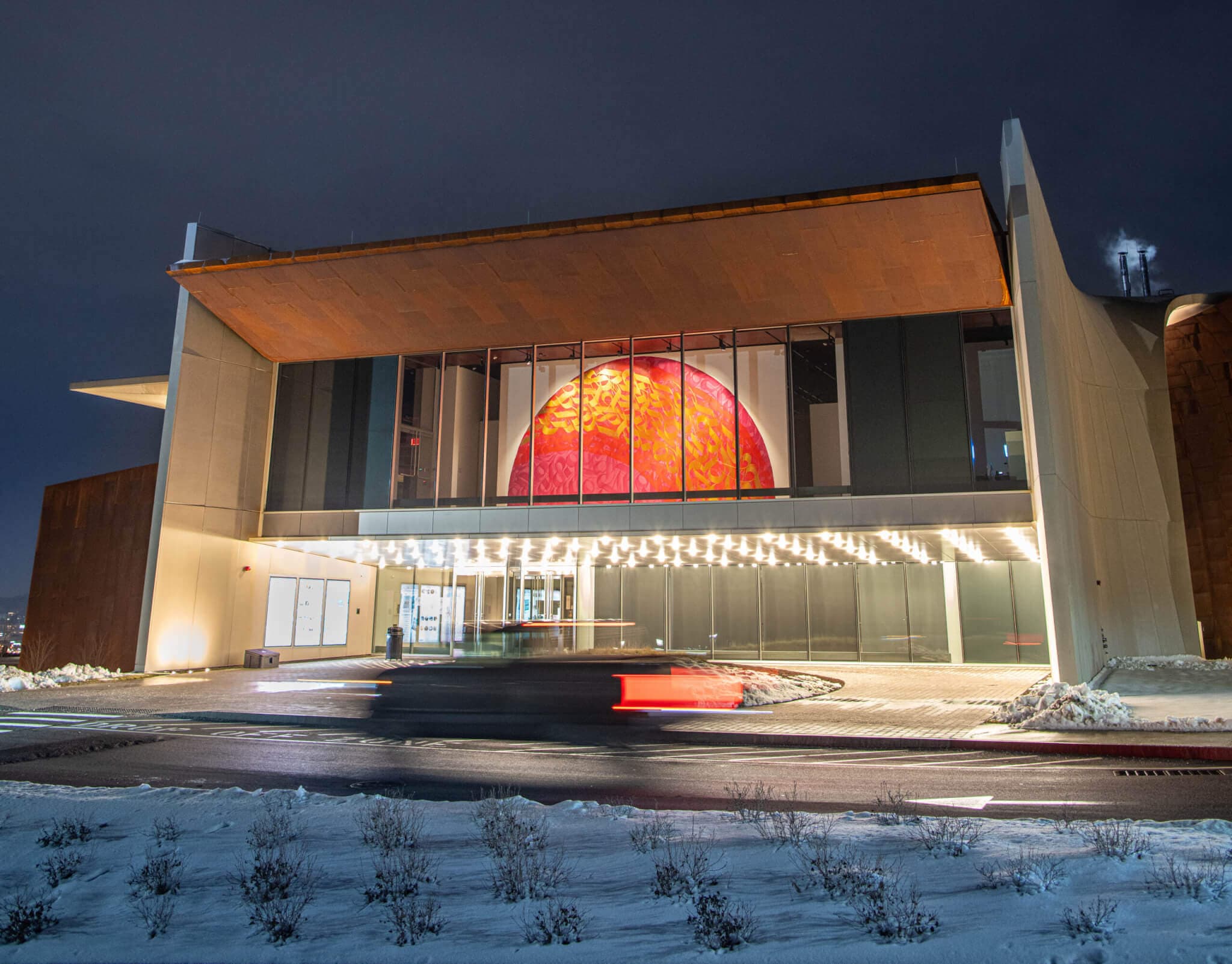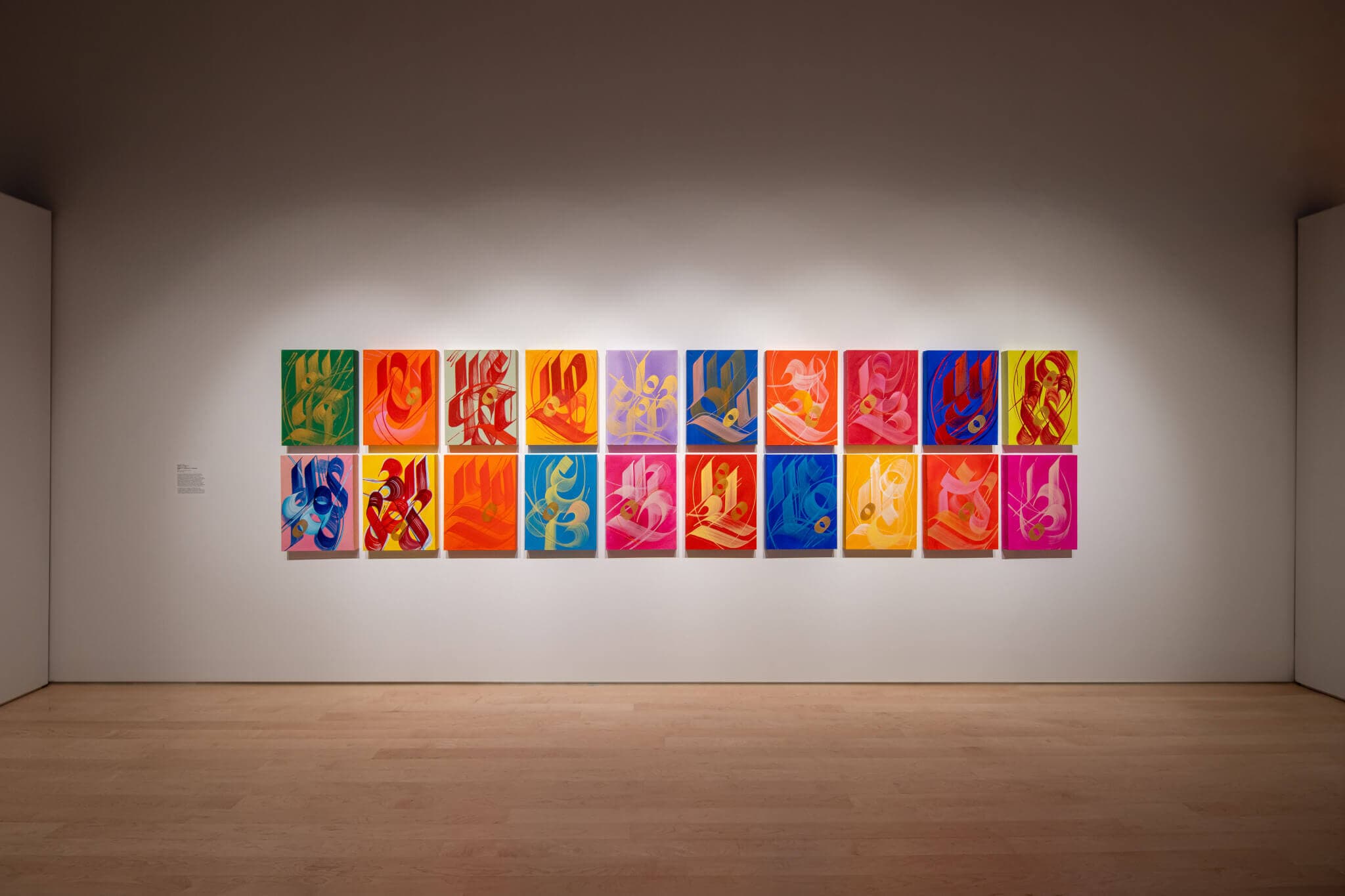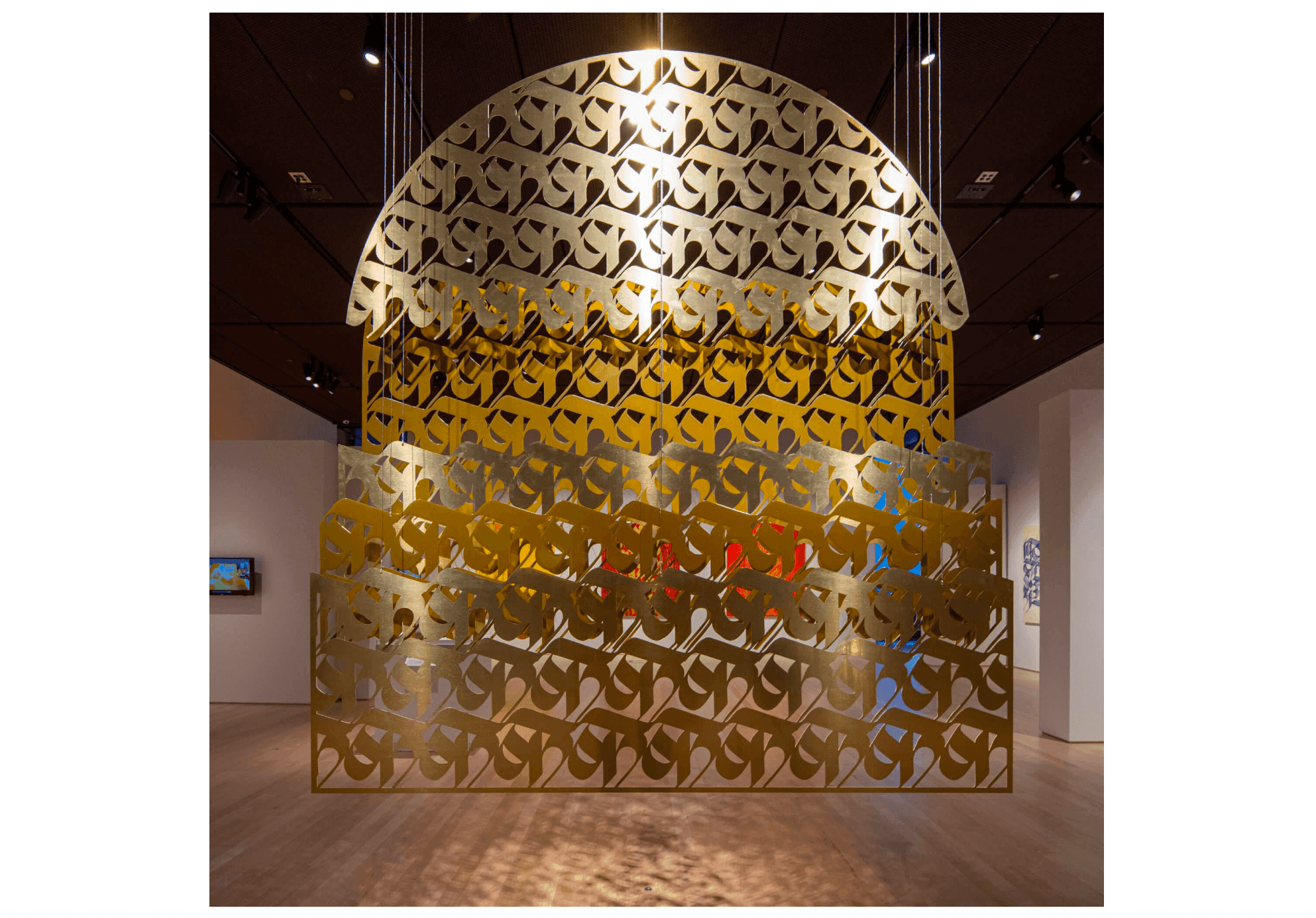With her first institutional solo exhibition, Sneha Shrestha, the artist also known as IMAGINE, has invited viewers to join her in recognizing daily acts of devotion. On view at the Iris and B. Gerald Cantor Art Gallery at the College of the Holy Cross in Worcester through April 9, Shrestha moves between reverent and playful, intimate and bold, tradition and innovation in the most comprehensive display of her work to date.
Around Boston and beyond, Shrestha is perhaps best known for her massive murals that combine Nepali and Sanskrit text and mantras with accentuated Devanagari script to create a visual language that is uniquely her own while calling attention to the overlooked beauty of the script itself. Shrestha works at dizzying scales with marks and gestures that are rooted in a rich graffiti history. In “Ritual and Devotion,” Shrestha transmutes her sweeping mantras into meditative studies on language, symbols, and systems. Embedded within these canvases, Shrestha reveals a deeply personal journey of perseverance.
In January of this year, I had the pleasure of spending time at Shrestha’s studio as we were planning for an event inside the space where she was finalizing an expansive (and largely new) body of work. Laid out on several rows of long tables were vibrant square canvases painted in bright oranges, blues, and pinks. Beside each canvas sat a photo of Shrestha’s mother wearing beautiful draping fabrics that matched some element of the adjacent painting. These are a collection of works the artist calls her Celebration series, as each photo of her mother was sent to Shrestha from a family gathering or celebration at home in Nepal that the artist couldn’t be present for during the long process of her immigration to the US. In many of Shrestha’s works, calligraphic forms present studies of the shape of the letters themselves, but in these colorful canvases, the texts are pulled from the names of the many immigration forms the artist filled out over years of paperwork—a process she claimed started to take on an almost meditative practice. Together on the canvas, we begin to see where sacrifice and hope overlap.
Layering has always been present in Shrestha’s work—lines of varying weights crisscross or swirl around one another to create small mazes for the eye to follow. It’s arguably what makes her work so captivating. Within the gallery, however, a refreshing new layer is added to her work: the personal and the familial.
Shrestha and I caught up inside the gallery at Holy Cross just days before a second body of her work was being prepared for an exhibition at the Rubin Museum in New York City. There, her pieces will be shown alongside Nepali ritual objects from the museum’s collection through October 6, 2024.
A closing talk about street art and community with the artist, Rob “ProBlak” Gibbs, and Caleb Neelon will be held on Tuesday, April 9, at 7:00 PM.
The following conversation has been edited and condensed.

From the exterior of the Iris and B. Gerald Cantor Art Gallery at College of the Holy Cross, Sneha Shrestha’s mural Devi (2023) is visible. Photo by Jane Louie Photography, courtesy of the artist.
Jameson Johnson: I just drove up to campus and could see Devi (2023), the massive pink mural, installed in the window of the Cantor Art Gallery glimmering like a beacon. Tell me about how that piece came to life.
Sneha Shrestha: The wall is visible from across the campus, but I knew that I also wanted to create something that could translate for up-close viewers. The view from the gallery is really lovely, especially during sunset. I wanted to create something that spoke to the environment here. So when the sun is setting, the light hits against it and illuminates the gold writing.
JJ: And this mural was the first piece you made inside the gallery, right? What is the relationship between your mural practice and the works that we’re seeing in the gallery?
SS: Yes, I created the mural in the fall of 2023, a few months before this exhibition opened. I think painting murals originally gave me visibility with the public. But the part that people don’t see is that it all starts in the studio. Without first creating a small painting that I can use as a prototype or to do my tests and experimentation with, the murals would never happen.
Now that I have people interested in my murals and my work in general, this show has been a great opportunity for me to give them a deeper sense of my process. When people see my murals, they have a big “wow” factor because of the sheer size, but I want people to ask questions and have conversations about it.
JJ: The work on view at the Cantor Gallery certainly invites conversation—it includes really personal bodies of work like the Celebration Series which features text pulled from immigration forms and colors inspired by clothing your mom wore to celebrations in Nepal that you couldn’t be present for. What has it felt like to show audiences this personal side?
SS: I think it was a push and pull in terms of creating the work and deciding what to reveal. In my studio, I had printed photos of celebrations that I missed during my immigration process. I couldn’t be present for those events so I just have the snapshot. When it came to the show, we went back and forth in terms of how we wanted to present the story, and then I decided that I don’t want to share all the photos that my mom sent to me. She is wonderful, and she might give me permission, but I just want to keep some things to myself.
JJ: What do you hope people take from these pieces?
SS: They all represent the luminous energy that my mother exudes despite everything that she’s gone through in her life. I like to think that during the years I was going through the immigration process, I was sort of embodying the energy that my mom taught me: how to be, as a form of resistance in itself. What does it mean to go through something, face it, and then to tell the story of that experience?

Sneha Shrestha, “Celebration” series, installation view, “Ritual and Devotion” at Iris and B. Gerald Cantor Art Gallery, 2024. Photo by Jane Louie Photography, courtesy of the artist.
JJ: Thinking about the title of the show, “Ritual and Devotion,” these pieces perfectly exemplify both of those words: We see the repetition of text pulled from the massive amount of paperwork you had to fill out during your immigration process, but we also see these gold circular symbols that punctuate each piece. What do they represent?
SS: Those are moon symbols called chandrabindu in Nepali and Sanskrit. My mom would draw these symbols on every sort of ritual object during the various festivals that we celebrate. And so for me, it kind of represents reaching a level of celebration or nirvana after completing something. My immigration process is now complete; I don’t think I would have been able to create these paintings before getting to the end of this journey.
JJ: You play both delicately and ambitiously with language and symbols. With your background as a graffiti artist and muralist, having your own style or set of symbols is really crucial. Here in the gallery, it’s clear that you’ve created symbols to represent different parts of your life. Could you tell me about how you’ve come to create your own visual identity?
SS: I’m definitely creating a visual language where people, even though they might not be able to read Nepali, still recognize these patterns that are in my work. They might see something similar in each painting—they’re starting to recognize that. And forming that visual language for me is important because it’s symbolic. It’s symbolic of the culture that I grew up in—the color schemes, the shapes that come with it, the organic shapes. It feels important to make people aware that different cultural aesthetics exist, maybe not in the mainstream, but we’re here.
JJ: I want to get back to this idea of ritual. When you’re thinking about ritual as it relates to festivals, holidays, or these symbolic gestures, how do you translate that reverence and history into an American context?
SS: I think ritual and ideas of devotion exist in all societies and communities. It depends on how we talk about it. I think the word ritual used to always be attached to Eastern cultures. But then if you think of the essence of what ritual means, it’s something that you repeat over and over again. You form a habit of doing it. It’s like celebrating Christmas every year. At the heart of this holiday is bringing family, or your chosen family, and your friends together. I think that’s this universal moment that I want people to realize: that these are things that are what make us feel at home at the end of the day, regardless of where you are.

Sneha Shrestha, DWARPALIKA, 2023, installation view, “Ritual and Devotion” at Iris and B. Gerald Cantor Art Gallery, 2024. Photo by Jane Louie Photography, courtesy of the artist.
JJ: At the center of the gallery, we have the hanging gate piece, DWARPALIKA (2023), which greets visitors as they enter the space.
SS: Yes, the title comes from a Sanskrit word that means goddess and protector—specifically a female protector. And the piece really was an extension of a sculpture I created for the Gardner Museum in 2020. The piece was inspired by these archways inside the Gardner Museum and questioning who those archways are for. They reminded me of archways from my home in Kathmandu Valley. I really love my new foray into sculpture. It gives a new way of creating a presence, of creating an environment in a similar way to what murals do. It has the power to transform a space, the power to stop people and make them look and think. We decided that after installing it, we really wanted to play with the light and shadows there, similarly to the mural outside that plays with light and changes throughout the day. Depending on how the sun hits the cutouts, shapes and shadows will emerge on the floor.
JJ: It’s been a really big year for you! Beyond this exhibition and your show with the Rubin, you’ve also recently become the first contemporary Nepali artist to have work acquired by the Museum of Fine Arts, Boston. I know you work a lot with youth and younger artists—do you have any advice you would like to share?
SS: Give yourself enough time to create the works, because in the past, I don’t think I gave myself enough time to create. This show has been in my mind and I’ve been marinating in these ideas for so long that, in a way, it was easy to produce the works because I knew what it was going to be about. I knew the story that I was telling. We didn’t need to come up with a theme and then work from it. So, I would say give yourself time to work and then time to rest. Drink disgusting smoothies to keep you healthy, if that’s what is needed, because that’s what I’m doing.

Photo by Jane Louie Photography, courtesy of the artist.
Boston Art Review and Sneha Shrestha aka IMAGINE collaborated to create a series of limited edition tote bags to celebrate this momentous occasion for Shrestha and kick off a new chapter for Boston Art Review. The tote bags are available for purchase here. $40 includes shipping. Follow Sneha Shrestha’s work on her website and on instagram @imagine876.





